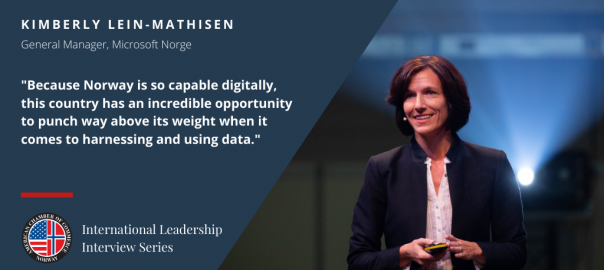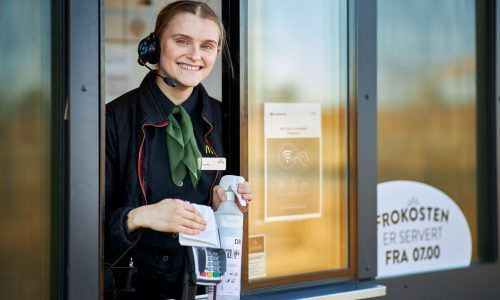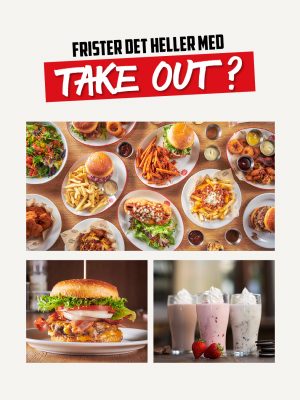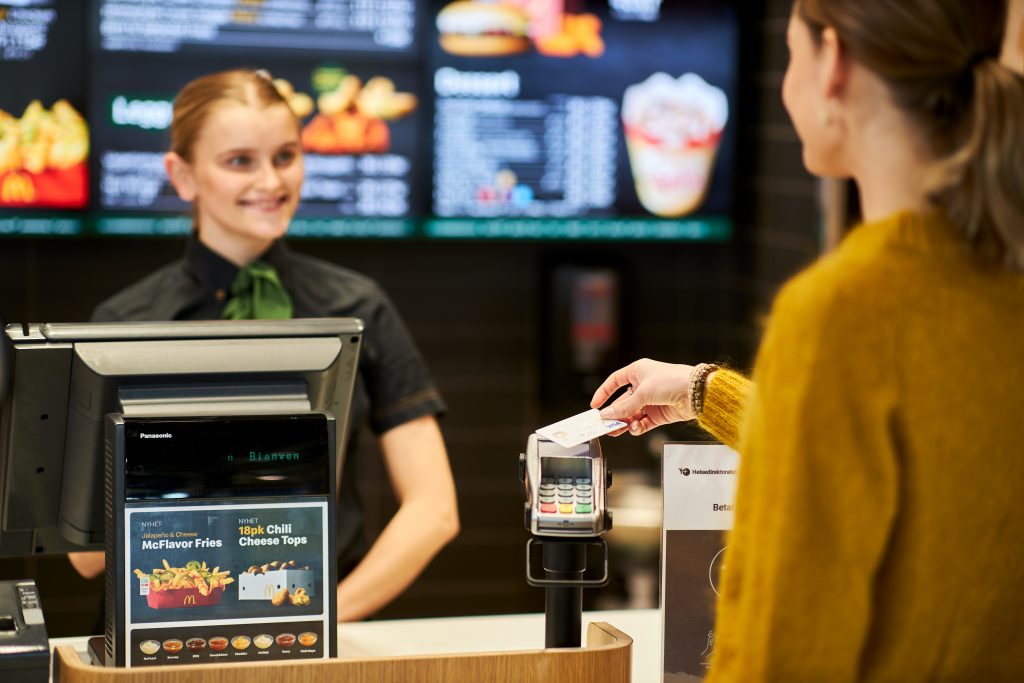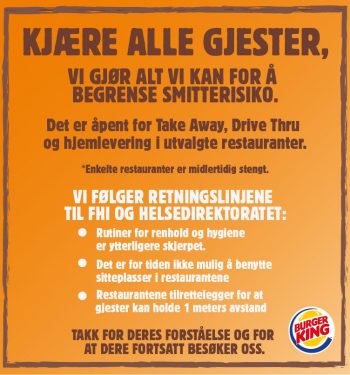A Journey of Change: An AmCham International Leadership Interview with Microsoft’s Kimberly Lein-Mathisen
In a globe-spanning career that has taken her from Chicago to Oslo, Microsoft Norge General Manager Kimberly Lein-Mathisen has earned a reputation for successfully leading international organizations through periods of transformational change. From highlighting the importance of lifelong learning to exploring Norway’s incredible potential to become a world-leading “Digitalt Lykkeland,” Lein-Mathisen sat down (virtually) with AmCham for a wide-ranging conversation on leadership in times of crisis and change.


From your beginnings near Chicago to your position leading Microsoft here in Norway, you’ve had quite the international career. Can you briefly tell us about how your international career took shape and how your different stops along the way have influenced your leadership style?
Briefly? Are you kidding? I’ve had so many chapters and so many brilliant experiences along the way, so, I’ll try my best!
I grew up in the US in a small town outside of Chicago. I trained as an engineer, and I wanted to work in a consumer facing global company. After I graduated from the University of Illinois, I started with Procter & Gamble. I worked in their factories for several years and really loved it. However, I just had this itch to get out of the Midwest and experience much more of the world.
After 5 years at P&G, I decided to take a step to realize this global dream and went to Harvard Business School to get an MBA. I chose HBS because it was the most internationally-oriented school that I could think of, and the incredible two years I spent there truly launched me on the global journey that I’ve been on since.
From Harvard, I found my first international position with Eli Lilly in the UK. I spent a brilliant 12 years with them, and they really gave me opportunities across the world, from Germany to Japan. Through these roles, I got to experience so many cultures – I was really living my dream!
One fine day about 5 years into that journey, completely out of the blue, Eli Lilly asked me if I wanted to be their General Manager in Norway. At the time, I thought it was very random that it should be Norway, but I was very excited for the job and up for the adventure. Norway was a great surprise to me. I moved up here and had the most amazing experience, though at the time I had no idea that the decision to move here would be the start of building the better part of my life, including meeting the Norwegian I would later go on to marry.

However, despite all this, my first stay in Norway only lasted two years. I was offered the chance to run Lilly Germany, which was a very large operation for Eli Lilly. This role led me to the next one, which was to lead Lilly’s global diabetes partnership with Boehringer Ingelheim, a German-based, family-owned international pharmaceuticals. My work there took me all over the world, giving me the opportunity to play a key role in launching new therapies in markets such as Japan.
At the same time, however, I had recently gotten married, started to have kids, so it was becoming trickier to spend so much time traveling. In the middle of all this, I remembered how much I loved Norway, and we decided to come back 10 years ago. I started off working with Orkla, where I had the chance to lead something truly Norwegian, Lilleborg, which was an exciting new challenge for me in comparison the US-based multinationals I had worked for previously.
It was an experience that turned out to be lots of fun. I entered at a very interesting time – the company was evaluating whether or not we could branch out beyond the Norwegian market. We were asking the big questions. Could we buy companies abroad? Could we renegotiate contracts? Could we really take this thing global?
And for a great three-and-a-half years, that’s what I got to do. But then I got another one of those unexpected phone calls. And that one came from a company called Microsoft.
And that’s where my latest chapter and my most massive transformation began. It has been an incredible opportunity to lead the Norwegian operations of such a global business. I grew up in America, so I understand the American mindset quite well. On the other hand, I’ve been in Norway many years, and I have also had the chance to work in many other countries. The ability to capitalize on all of that, to bring all of these different experiences together in an incredibly fast-paced, innovative environment is extremely rewarding.
In your future of work interview with BI, you noted that, “The area where companies are the least exercised is a little worrying. It is around investing in employees and people and all the dimensions around the individual,” before going on to conclude that this investment has a lot to say in terms of a company’s agility and ability to adapt. How do you as a leader engage with your employees to ensure their development?
About six years ago, Microsoft started on a profound journey, a journey of change that really needed to happen. CEO Satya Nadella and our company leadership made an exceptionally wise commitment to pursue a culture transformation alongside the technology and business model overhaul. Central to this cultural transformation is a framework called the Growth Mindset, which comes from Stanford University professor, Carol Dweck. The Growth Mindset is not a corporate program. It’s for people. It’s for your life. It’s about always learning and developing.
We really came together around this idea of being on a growth journey, which was fundamental for all of us at Microsoft. For years, we had done extraordinarily well with a very closed business model. The problem with success in a closed business model is that you tend to develop some aspects of your culture that are not good, such as a lack of empathy and a false confidence that you already know everything. We needed to understand that we didn’t know everything and shift our posture fundamentally, becoming much more curious and developing a lot of deep listening muscles.
Here in Norway, we looked at many aspects of our business through the lens of renewal and a desire to foster learning. And that led us to change a lot of things, for example, in our business reviews, we needed to do a much better job of focusing on learnings not only numbers. We’ve shifted our priorities to align better with our customers and partners, and profoundly changing how we think about who we promote, who we hire, and our entire rewards system. If you asked me to boil it down, I would say the most fundamental thing we decided to dedicate ourselves to is developing an “always-on learning culture.”
It’s something that goes so far beyond the idea of sending people to a training course once a year. We’re breaking down the acquisition of skills into bite-size, stackable components – creating on-the-go, on-the-job ways of acquiring and applying skills that we as leaders must continuously update. We’re also making these processes fun, while creating clear expectations that ensure people deliver on their learning objectives, and at Microsoft, I feel like we’ve made great learnings and great progress on that journey.
We’re going to shift gears a little bit and talk a little bit about sustainability. There has been increasing discussion in Norway about building a sustainable, future-oriented economy, and there’s no doubt that companies will be the driving force behind this transition. What unique challenges – and opportunities – does sustainability present for corporate leaders, particularly in Norway?
As leaders, we really have to rise to meet this call – technology and the role it can play in addressing environmental challenges are compelling themes that are really resonating around the world right now.
I strongly believe that Norway is called to an even higher level here. We live in a country that has done a remarkable job of lifting every single person in society to an incredibly good standard of living. However, there is simply no getting around the fact that the oil sector – that stands for a tremendous amount of value creation in this country and plays a critical role in funding our public sector – is pumping out CO2 emissions.
Therefore, we have a situation that we must address in Norway. The world is becoming more and more impatient when it comes to converting to renewable energy, and this puts direct pressure on Norway to figure out how it’s going to make an enormous amount of value creation much more sustainably. We’ve had it so good in Norway that we’re not used to dealing with crisis and having to change. In actuality, however, there’s a mounting crisis that has nothing to do with COVID but has everything to do with the possible after-effects of a world that simply must become more sustainable.
It is clear that this crisis is going to mean profound things for Norway. The bright side of all of this, however, is that we are one of the countries in the world best positioned with strategic advantages to become a “Digitalt Lykkeland.” We have a very knowledgeable, skilled, and digital workforce. Given the digital capabilities that we have, the trust fabric in our society, and the abundant clean hydropower fueling our data centers and other industries, we are better placed than nearly every country on earth to reinvent our traditional businesses into digital businesses.
And I have to tell you, we’ve already gotten started with this shift. If you tell me the name of nearly any large Norwegian company right now, I can tell you the name of their digital platform. If these companies do their work well, these platforms might be better known than their respective parent companies in the course of the next few years. These digital platforms are going to be one of the key drivers of growth for Norwegian companies going forward. And I haven’t even touched on how we can use data collaborations to create value – we’re still very much in our infancy there. That’s going to be extremely important for value creation in this country going forward.
We’re going to circle back to development for the next question, however, this time we’re going to focus on you. How do you continue to grow and develop as a leader yourself?
I’ve never been pushed harder to learn in my whole career than I have in the last three years with Microsoft. We have so many innovations that are being rolled out and all of this technology can be applied in so many different ways depending on the industry. Therefore, I not only need to understand these technological innovations from our perspective, but I have to fully commit to making time to be curious to truly learn about how these new elements can make a difference for the companies we serve.
Therefore, the level of investment I make each day in deepening my understanding, is quite intensive. I might spend one day working with shipping leaders to better understand how technology can help in industry and the next talking to executives at one of Norway’s large grocery chains or banks about how technology can bring value to them.
I often find myself deeply engaged in the energy sector, which is, of course, a very large part of what we do in this country. There are big global challenges to be solved here, so I’m often thinking about how technology can be harnessed to substantially reduce carbon emissions, promote renewable investment, and assist energy companies in digitalizing sustainably.
“Today truly delivered on my expectations – the presenters certainly provided a lot of food for thought,” concluded one participant.
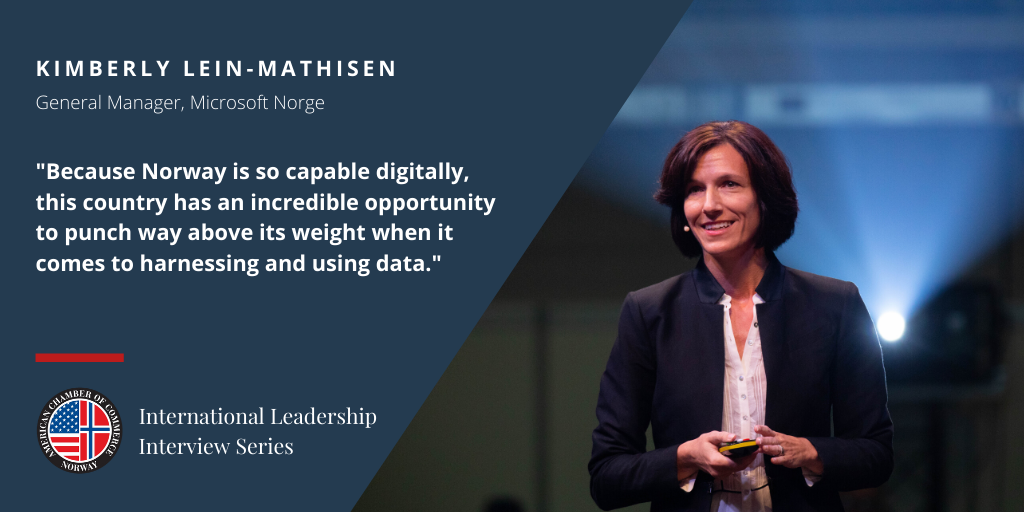
Another thing I do, whether it’s a meeting or the opportunity to speak at a conference, is deliberately say yes to engagements on topics I know will stretch me – in areas where I know that I don’t have all the answers, but I also know I want to push myself to collect more insights, to provide something of value. That tool, simply saying yes, is so powerful and forces me to commit to learning in order to prepare.
The other top self-development tip that I would have is to use LinkedIn!
I really adore LinkedIn, however, just like everyone else, I always think that I don’t have time for it. Despite that feeling, I find time to go on it almost every single day. I try to share things on LinkedIn often, which forces me to crystallize my thoughts, really focusing on what’s truly interesting and the message I want to deliver. LinkedIn is also a fantastic way to get outside of my own echo chamber, allowing me to continuously hunt and search for new knowledge, new connections, and different points of view.
Now to an issue I know you are quite familiar with – cross boarder data openness vs. data protectionism. Why is this issue so important, and what can the Norwegian government, companies, partner organizations, and the public do to better collaborate?
That’s a really big question, but I’m so glad you asked because the implications of this question really get to the core of the most important opportunities for value creation Norway is going to have in the future.
To begin with, any country or any block of countries, like the EU, can make choices about the exportation of all kinds of goods, including data. In our digital world, stakeholders have to make choices about how open they want to be around data versus how protective they want to be. Of course, there are many legitimate reasons why stakeholders might have concerns about sharing data, in regard to security, privacy, and how its handled more generally.
Keeping those concerns in mind, however, if you fundamentally think about Norway’s position in the global data economy, Norway is a very, very small country, and while there is indeed an aspect of data directly related to people, there is also a huge universe of business-to-business or industrial data which often isn’t tied to any aspect of a person itself. Because Norway is so capable digitally, this country has an incredible opportunity to punch way above its weight when it comes to harnessing and using this data. We need to understand, however, that if we’re going to drive export value, we’re going to need to be able to provide data-driven digital solutions that compete out in the world, and we’re simply not going to be able to do that based on data only generated in Norway.
Healthcare is a classic example. We often hear about the great healthcare registers we have in this country, and they are indeed assets for us. But let’s be clear – if you’re going to leverage data to develop a cure for cancer, for example, then you’re going to want to build something that goes far beyond a dataset of just five million people – a global data commons. That’s when you’re going to break through and find a cure for cancer or move the needle on, for example, ocean research, where we can use data to generate economic value while simultaneously doing important, critical things for the planet.
Therefore, we need go beyond the all-or-nothing question of, “Do I share my data or do I not share my data?” We have to think much more expansively and creatively, forming new commercial models supported by technologies thar enable confidential computing, multi-party sharing arrangements, and things that we haven’t even imagined yet.
To make this happen, however, the government has to dive into this big legacy set of laws with a mindset to accelerate sharing and value creation, while at the same time keeping in balance the need to ensure privacy and security. In Europe, and more specifically in Norway, we’re going to have to do that in a responsible way. There’s nothing else that’s acceptable to our population, our mindset, and our values, so it almost goes without saying that you’ll never get this done if you only focus on the opportunity side.
If Norway is going to be able to compete in this game and provide digital solutions out to the world, these solutions are going to need to be based on truly global data and an increased sophistication in commercializing it. This is not something that is going to happen automatically, however. It will require digital savviness, agility, and an ability to execute many processes simultaneously.
And if you link it all the way back to your data, one has to ask, “If you shut your borders to data and you’re a super small country like Norway, who do you think is going to share their data with you?” That question really is at the heart of a country’s chances to become a winner in any of these data-driven value competitions that every country will need to compete in going forward.
Building off that, if you had the podium at Stortinget for five minutes, what topics to address?
I would absolutely talk about creating a “Digitalt Lykkeland.” I would do everything I could to relay that our future is digital. Let’s make the commitments necessary to lift the capabilities of this country to the next level because we already have so many incredibly competitive assets. We simply need to recognize them and most importantly find a way to become quicker in implementing competitive frameworks so that we can retain our advantage vis-à-vis the rest of the world. In this country, if we lack anything fundamentally, it’s speed. We have everything else we need!
If your job was a sport, what sport would it be and why?
I could probably choose many analogies, but the first one that jumped into my mind is a sport that I’ve actually never played. In fact, I had never even seen it before I moved to Norway – handball!
Now, I can’t say I know a lot about the technical aspects of the game itself, but it’s a great analogy for my job because handball seems to be an incredibly intensive game. It’s very fast-paced, new things emerge all the time, and your skills are super important. To make things even more complicated, you have to put all these moving pieces together to work with your teammates to put together an agile, competitive strategy. You can’t snooze for a moment, and the game demands a tremendous amount of dedication and commitment.
That all really resonates with me. At Microsoft, we’re operating in an incredibly fast-paced environment where we collaborate with all of our great clients and partners to tackle new challenges. Handball simply represents that unique combination of intensity and being so multi-faceted really well.

Where do you see yourself and Microsoft in the next five years?
Well, I’ve got this technology and sustainability bug deep in my in my DNA. I believe Microsoft is going to continue to create this fantastic, digital, and future-oriented fabric of technology, a constantly evolving platform that represents one of the world’s strongest ecosystems, which for me means that you have hundreds of thousands of companies vibrantly building on top of this platform – a collaborative process that creates a tremendous amount of winners.
On a personal level, as a classic industrial engineer, I have a really strong passion for data-driven business collaborations that can break down some of the seemingly “impossible” problems we have in this world, and I really want to pursue that passion the next five years. I spent 12 years in healthcare, and those 12 years instilled a real excitement around how we can leverage new technologies and abilities to drive us forward as a human race. To cure cancer, to cure epidemics, and to deepen our understanding of how we can build a more sustainable future.
If you could give your 20-year-old self some advice, what would it be?
The advice I would give to any 20-year-old, including myself, is to expose yourself to everything you can while you’re young and be sure to learn a lot about technology on your way.
Personally, I’m so glad that I studied engineering, however, I would encourage everyone, no matter what you’re studying, to include a technology component. Whether you choose nursing, education, finance, or construction, my strongest advice is to dive in and equip yourself with the technology background you’ll need along the way. You don’t have to be a coding expert in every programming language – digital tools are getting better and easier to use every day.
In short, have a strong heart for the aspects of technology that can help you succeed in your field. Don’t be afraid of it, make it your friend!

When was the latest time you responded to an email last night?
It was about 1:15 in the morning before I got off email. Now that’s not me saying that is a brilliant example, but let’s remind ourselves that we are in a time of crisis, and times like these force us to adapt, evolve, and, in some cases, answer emails just a bit later than we’d like to admit.

